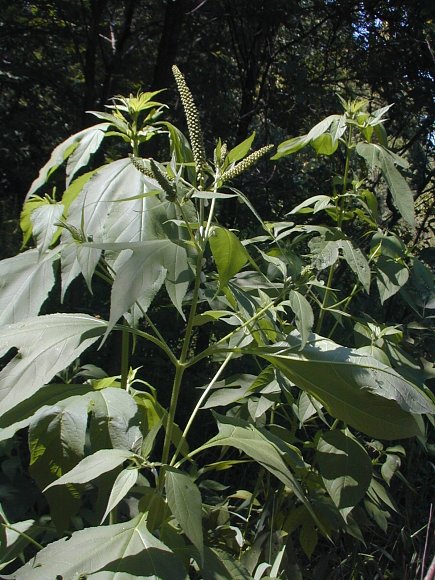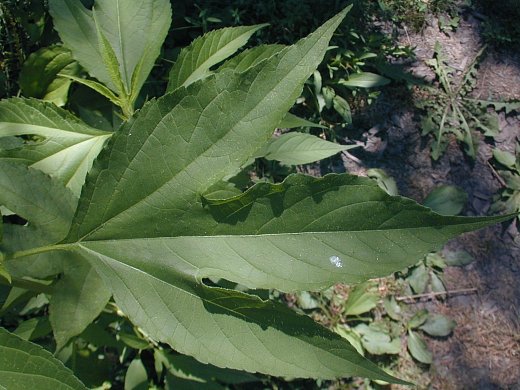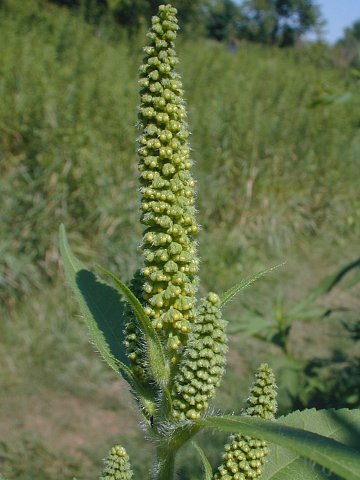Description: This plant is a summer annual that becomes 3-12' tall, branching occasionally. The green stems are covered with white hairs. The opposite leaves are up to 12" long and 8" across. The larger leaves are divided into 3 or 5 lobes, usually serrated along the margins, and have long petioles that are sometimes winged. The smaller leaves near the base of an inflorescence are lanceolate and often hairy underneath. Many of the upper stems terminate in a cylindrical spike of flowers, about 3-6" long, with one or more smaller spikes near its base. The small flowers are are yellowish green and devoid of petals and sepals. They occur in small drooping clusters less than ¼" across on short pedicels, and are densely arranged all around each spike. The fine pollen of the male flowers is easily carried aloft by the wind. This typically occurs during late summer or early fall. The seeds are large, tough-coated, and remain viable in the soil for several years. The root system is fibrous.

Cultivation:
The
preference is full sun to light shade, moist conditions, and fertile
loamy soil. Under these circumstances, Giant Ragweed can develop into a
huge plant. It also tolerates slightly drier conditions, but the large
leaves have a tendency to wilt and wither away if there's a significant
drought. Poor soil containing some clay or gravel is also tolerated –
under these less than ideal conditions, this plant will be smaller.
This common weed may introduce itself spontaneously to the wildflower
garden or a native habitat without any official encouragement.
Range
& Habitat: The native Giant Ragweed is
a common plant that occurs in every county of Illinois (see Distribution
Map). It can be found in disturbed areas of moist to mesic
black soil prairies, especially along the margins near woodlands or
fields. Other native habitats include disturbed areas of moist clay
prairies, meadows in woodland areas or near rivers, thickets, and
woodland borders. In more developed areas, it occurs in vacant lots,
cropland, abandoned fields, poorly drained waste areas, areas along
roadsides and railroads, and fence rows.

Faunal Associations: The flowers depend on wind pollination, therefore they attract few insects. However, Apis mellifera (Honey Bee) has been observed to gather pollen. Many insects feed destructively on the foliage, plant juices, and other parts of Giant Ragweed (Ambrosia trifida). These insects include the stem-boring larvae of long-horned beetles, Zygogramma suturalis (Ragweed Leaf Beetle) and other leaf beetles, larvae of weevils, stem-boring larvae of tumbling flower beetles, larvae of leaf-miner flies, Chlamydatus associatus (Ragweed Plant Bug) and other plant bugs, Acrosternum hilaris (Green Stink Bug) and other stink bugs, Uroleucon ambrosiae (Brown Ambrosia Aphid), Stictocephala bisonia (Buffalo Treehopper) and other treehoppers, larvae of Schinia thoreaui (Thoreau's Flower Moth) and many other moths, and Melanoplus differentialis (Differential Grasshopper); the Insect Table has a more complete list of these insect feeders. Because of their hard coat, the seeds of Giant Ragweed are less attractive to birds than the seeds of Common Ragweed (Ambrosia artemisiifolia). However, the Mallard duck and Greater Prairie Chicken eat the seeds to some extent (Havera, 1999; Yeatter, 1943). The seeds of Giant Ragweed are also eaten by the House Mouse, White-footed Mouse, and Deer Mouse to some extent, while the Meadow Vole feeds on young shoots (Whitaker, 1966; Lindroth & Batzli, 1984). The bitter foliage of this plant is not a preferred source of food for mammalian herbivores, although the Domesticated Goat will eat it (Blackmore, 1998). Because of the insects that are attracted to large dense colonies of Giant Ragweed, the Indigo Bunting, Song Sparrow, White-throated Sparrow, American Redstart, Yellow Warbler, and other songbirds during fall migration inspect the foliage of this plant for insects (Wilhelm & Rericha, 2017).

Photographic
Location:
The photographs were taken at Meadowbrook Park in Urbana, Illinois.
Comments:
This huge plant is probably an allergy sufferer's worst nightmare.
Giant Ragweed (Ambrosia trifida)
has some ecological value to various insects and insectivorous
songbirds as a source of food and protective cover, otherwise it
is less
important ecologically than Ambrosia artemesiifolia (Common
Ragweed). Giant Ragweed can be distinguished from other Ambrosia
spp. (ragweeds) by its palmately lobed leaves; other ragweeds
have leaves that are pinnatifid or bipinnatifid. The name of this genus
of plants refers to ambrosia, "the food of the gods" in antiquity. This
seems like a strange name for a group of non-showy plants with bitter-tasting foliage.